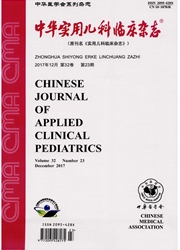

 中文摘要:
中文摘要:
目的分析早产儿支气管肺发育不良(BPD)的临床特征和探讨其发生的高危因素。方法选取2011年1月1日-2012年12月31日我院新生儿重症监护室收治的住院28d以上的早产儿,对其临床资料进行回顾性分析,根据患儿是否出现氧依赖(〉21%)超过28d分为BPD组和非BPD组。其中氧依赖(〉21%)超过28d的新生儿纳入BPD组,其余为非BPD组,对两组患儿的临床资料进行对比研究,分析发生BPD早产儿临床特征和危险因素。结果共227例患儿符合纳入标准,其中67例发生BPD,160例未发生BPD,BPD的发生率为29.52%。BPD与非BPD组的单因素分析发现胎龄、出生体重、性别、吸氧浓度〉40%、宫内感染性肺炎、机械通气、新生儿呼吸窘迫综合征(RDS)及动脉导管未闭(PDA)与BPD的发生密切相关(P〈0.05)。Logistic回归分析发现,胎龄和出生体重为保护因素,宫内感染性肺炎、机械通气为危险因素。结论提示出生体重低、胎龄小、宫内感染性肺炎、机械通气为BPD发生的危险因素,应尽可能降低这些因素的发生。
 英文摘要:
英文摘要:
Objective To describe the clinical characteristics and risk factors of bronchopulmonary dysplasia(BPD)in preterm infants. Methods A retrospective analysis was conducted on the premature infants cared at NICU of our hospital for more than 28 days from January 1,2011 to December 31,2012.And they were divided into a BPD group and a non-BPD group according to preterm infants with or without oxygen-dependence(〉21%)over 28 days.Infants with oxygen-dependence(21%)over 28 days were assigned to the BPD group and the others were assigned to the non-BPD group.The clinical records of the two groups were compared and the clinical characteristics and risk factors of BPD in preterm infants were analyzed. Results A total of 227 patients were included in this study.The incidence of BPD was 29.52%(67/227),160 of 227cases did not suffer with BPD.An univariate analysis revealed that gestational age(GA),birth weight(BW),sexual distinction,high concentration of oxygen inhalation(〉40%),infectious intrauterine pneumonia,mechanical ventilation,Newborn Respiratory Distress Syndrome(NRDS)and patent ductus arteriosus(PDA)had close association with BPD incidence(P 〈0.05).Logistic regression analysis showed that GA and BW were protective factors of BPD while infectious intrauterine pneumonia and mechanical ventilation were risk factors. Conclusion Low BW,small GA,infectious intrauterine pneumonia and mechanical ventilation are risk factors of BPD,clinically we should try to avoid these risk factors.
 同期刊论文项目
同期刊论文项目
 同项目期刊论文
同项目期刊论文
 期刊信息
期刊信息
